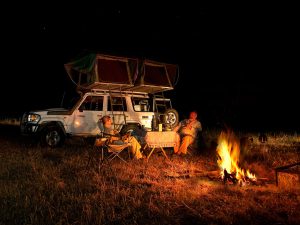How to Build a Campfire?
 Master the art of how to build a campfire with our comprehensive guide. Enhance your Ugandan adventure with a cozy campfire. Perhaps no other activity screams summertime as much as sitting around a campfire, whether at a sunset beach bonfire or deep inside a national park. But as many beginner campers know, it’s hard to experience the fun of roasting s’mores and telling ghost stories around a roaring fire if you don’t know how to build that roaring fire.
Master the art of how to build a campfire with our comprehensive guide. Enhance your Ugandan adventure with a cozy campfire. Perhaps no other activity screams summertime as much as sitting around a campfire, whether at a sunset beach bonfire or deep inside a national park. But as many beginner campers know, it’s hard to experience the fun of roasting s’mores and telling ghost stories around a roaring fire if you don’t know how to build that roaring fire.
While building a fire may seem easy, challenges like wet matches or heavy winds can put a damper on your s’mores. But with a few simple techniques and supplies, you can easily learn how to build a campfire or become the campfire master for your next summer camping trip and help ensure everyone stays outside long after the sun goes down.
What you will need, to build a Campfire?
A plan for building a campfire requires more refinement than just finding wood around your campsite, though foraging for sticks is usually helpful. To make your campfire, you’ll need a few basic items.
- Kindling: Small pieces of wood, called kindling, catch fire quickly and will ideally help your larger logs catch fire.
- Larger Pieces of Wood/Logs: Be sure to have enough logs to keep your fire going. You don’t want your fire to burn out while you’re out in the woods looking for logs (nor do you ever want to leave a campfire unattended.)
- An Incendiary Device: This is matches or a lighter for most people, but others may prefer to use flint or other more renewable fire-starting resources. If you carry matches, be sure to keep them in a waterproof container. Products like the Fuel Free Lighter and Mag Striker with Tinder Cord can be useful items to keep in your camp kit.
- A Flammable Object to Light: Most people use newspapers when building a fire in a hearth. However, you don’t want to use unnatural materials outdoors or burn anything that releases harmful chemicals, so opt for items like natural cotton or recycled coffee grounds. These items light faster than kindling and make it much easier to build a roaring fire on your first try.
Methods of how to build a Campfire
Building a fire isn’t an exact science, but there are some tried and true methods that can help you quickly get your fire going. For beginner campers, either the Log Cabin or Pyramid method will be the best way to build a campfire. No matter which method you use, always start small with your tinder and build up to your larger materials and remember to be patient. Once the medium-sized logs begin to catch fire, you can add larger logs.
- The Pyramid Method: This is the most well-known method, and also the easiest. Place your kindling and fire starters in the middle and stack your other logs around it in a pyramid (or conical shape) leaning the top ends against one another. Put your thinner sticks and kindling in the middle and larger logs on the outside.
- The Log Cabin Method: Start with your kindling and fire starter in the center and use four logs to build a square around it. Continue stacking logs in a square shape as if you were building a traditional log cabin. This type of fire burns very hot but it can take a while for the outside logs to get roaring. You can alter this a bit by creating a small pyramid-style fire in the center, building in a triangle shape instead of a square, or using one much larger log to form a “wall” on one side, which can help protect the fire in windy conditions.
How to keep the fire going?
Fire not lasting as long as you would like? A lot of fires go out because the bottom logs burn out and the fire gets ‘cold.’ As the fire burns, keep the logs close together while still providing space for oxygen. Often this means aligning bottom logs parallel to one another so more heat is conserved. Too much space between the bottom logs could be a reason why your new logs on top aren’t catching fire.
When selecting logs, the dryer the wood, the easier it’ll be to catch – but it’ll also burn quicker. Consider alternating between recently felled (cut) and bundled (dried) wood to get the best of both worlds.
How to Extinguish a Campfire?
It’s no secret what puts out a fire: water, and lots of it. Materials that block oxygen like sand and dirt can also assist in extinguishing your fire.
When extinguishing your fire, make sure to cover the entire base and each log in water. Using a stick or fire poker, disassemble the fire, knocking all the remaining wood on the ground (within the fire pit.) Once the fire is disassembled, douse the logs in water and mix the ash with a stick as you pour water on the ground to ensure no hot ashes are hiding under the top layer. Logs can also burn on the inside even if they appear to be unlit from the outside, so it’s best to try to break larger logs left on the fire into smaller pieces before extinguishing.
A poorly extinguished fire can come roaring back to life hours later if even a single ember is still burning and it’s every camper’s responsibility to prevent fires. You are entirely responsible for your fire and any damage it may cause. Many campers prefer to extinguish their fires twice: once before they start getting ready for bed, and again 30 minutes or so later before turning in to double-check that nothing is still burning.
Campfire Safety and Useful Tips
- Always check if campfires are allowed where you are. It is your responsibility to know the current fire regulations.
- If you are camping outside of a designated campsite, fires may be completely banned. Again, check local regulations in advance.
- Don’t leave your cardboard or food boxes at your campsite. While some campers may think they’re leaving campfire materials for the next users, in reality, it’s just leaving trash in the woods, and the smell of food can attract animals. Carry out everything you carry in from designated and backcountry campsites.
- Never leave a fire unattended, and keep all flammable materials including shoes, blankets, grass, extra logs, and kindling several feet from the fire. Keep it even further away during heavy winds.
- Only make fires in designated fire circles. Most official campsites will have one fire ring per site, often with a removable grill on top. Before starting your fire, check to make sure there’s nothing flammable in the fire ring (like grass or trash) and stack extra rocks along the perimeter if needed.
- You may not be able to bring your own wood. If you’re camping more than 150 miles or so from your home, there’s a good chance you’re not allowed to bring your own firewood. This isn’t to force you to buy firewood at the camp store. Firewood can carry invasive plants, animals, and diseases, so many destinations ban non-local wood to help protect sensitive environments.

